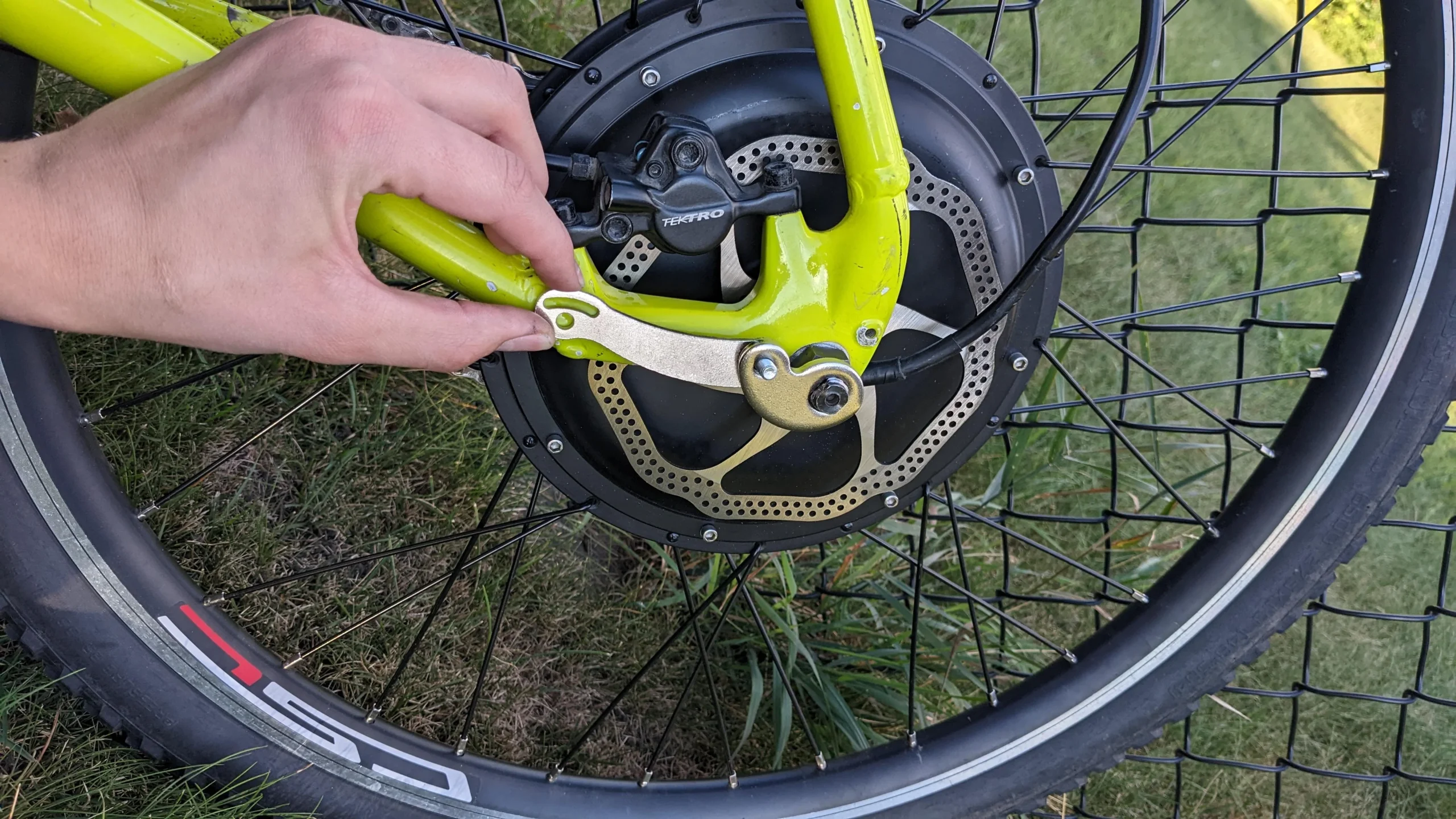Electric bicycles put serious twist through their axles, especially high-powered hub-motor builds and bikes that use regenerative braking. That torque has to go somewhere. Without a proper torque arm, it goes into the dropouts, where it can chew the slots, loosen axle nuts, and, in the worst cases, spin the axle right out. A Universal Laser Cut Torque Arm solves that problem by spreading motor forces into the frame safely, and by fitting a wide range of eBike configurations with precision. Learn more about how these compact plates do outsized safety work below.
Why torque arms are critical for axle and frame protection
A torque arm is a simple lever that captures the motor axle’s flat faces and anchors that rotational force into a sturdier part of the frame or fork. When a hub motor produces torque, the axle wants to rotate in the dropout. Stock anti-rotation washers help a little, but they’re not designed for repeated, high-load use. A torque arm is.
Here’s what it does in practical terms:
- Prevents axle spin-out by creating a longer moment arm that resists rotation.
- Distributes load into thicker, stronger frame sections rather than concentrating stress at the dropout slot.
- Keeps axle nuts tight by minimizing micro-movements that cause loosening.
- Maintains rotor and rim alignment, reducing brake rub and wheel tracking issues.
Small tolerance errors add up during hard launches or hill climbs. With a properly fitted universal laser-cut torque arm, the axle flats seat fully and consistently, so the motor’s torque doesn’t “chew” aluminum or soft steel dropouts. Over time, that’s the difference between a frame that feels tight and predictable and one that develops creaks, misalignment, or, worst case, a cracked dropout.
The risk of axle spin-out in high-powered eBikes
Axle spin-out isn’t hypothetical, it happens when torque overcomes dropout friction and the thin metal around the slot deforms. The risk increases with:
- Higher motor torque: Many 1,000–1,500 W hub motors produce 80–120 N·m of torque. Short, hard bursts (and regen braking) spike loads even higher.
- Softer or thinner dropouts: Aluminum frames and especially front forks are more vulnerable than stout steel dropouts.
- Insufficient clamping force: Under-torqued axle nuts, worn washers, or contaminated threads reduce holding power.
- Regen braking: Reverse torque applies the same problem in the other direction. Without a torque arm, the axle can walk in the slot with each stop.
What does a spin-out look like? The wheel can skew in the frame: washers scar the dropout: braking suddenly feels off: in severe cases, the axle rotates out of the slot. On a front hub, that can be catastrophic. A Universal Laser Cut Torque Arm adds a mechanical stop, so even if nuts loosen slightly, the axle can’t rotate freely.
How laser cutting ensures universal fit and precision
Not all “universal” torque arms are equal. Laser cutting is what makes a universal design genuinely fit a range of axles and frames without slop.
Precision matters in three ways:
- Tight axle interface: Laser-cut slots can be held to tight tolerances, so the flats on 10 mm or 12 mm axles seat fully with minimal play. Less play equals less shock loading on start-up.
- Consistent geometry: Clean edges and repeatable cut profiles mean the keyed shapes, anti-rotation tabs, and multi-hole link arms all line up as intended. That consistency is hard to achieve with stamped or low-cost cast parts.
- True “universal” adjustability: Because laser cutting allows complex shapes without new tooling, manufacturers can add elongated holes and multi-position anchors for:
- Front or rear installs
- Left or right orientation
- Varying chainstay/fork-arch clearances
- Different axle diameters and dropout thicknesses
A good Universal Laser Cut Torque Arm also gets proper post-processing, deburring and sometimes a light surface finish, so edges don’t act as stress risers. The result is a precise, quiet fit that doesn’t need backyard filing to make it work.
Material choices that influence torque arm durability
Material is the other half of the equation. The torque arm must be tougher than the dropout surface it’s protecting and strong enough to resist long-term bending.
Common choices and trade-offs:
- Stainless steel (304/316): Corrosion-resistant, plenty strong for most commuter and cargo builds. Thickness typically 3–5 mm. 316 offers better corrosion resistance for wet climates.
- Chromoly steel (e.g., 4130): Higher strength than standard stainless and can be heat-treated. Often used at 4–6 mm for heavy-duty, high-torque or regen-intensive setups.
- Mild steel: Works if made thick and paired with a robust anchor, but more prone to bending under repeated shock loads. Usually found on budget arms.
- Aluminum: Rarely recommended for the axle interface. Even in 7075, the contact faces can gall and wear under high torque.
Finishing and hardware matter too. Look for:
- Thick, flat plates that don’t flex when torqued.
- Properly sized M5/M6 fasteners with class 8.8/10.9 ratings or stainless equivalents.
- Quality clamps or frame anchors that won’t slip on painted tubes.
In short, a Universal Laser Cut Torque Arm made from hardened or high-grade stainless/chromoly, with stout hardware, will outlast the wheel build it’s protecting.
Installation guidance for different eBike motor setups
Every frame is a little different, but a few principles apply across front and rear hubs, geared or direct-drive.
General steps
- Dry fit everything: Seat the axle flats fully in the dropout. Confirm the torque arm’s axle slot engages the flats with minimal play.
- Choose the anchor point: The arm should point toward a rigid member, chainstay, seatstay, or fork leg, so the link can clamp or bolt securely. Avoid thin fender struts or small eyelets as the sole anchor.
- Align without pre-load: The link should reach its anchor without forcing the arm to twist. If it’s fighting the frame, adjust the hole position or flip the arm orientation.
- Torque and threadlock: Install axle hardware clean and dry (unless the motor spec calls for a specific lubricant). Use blue threadlocker on arm bolts/clamps. Typical hub axle nut torque ranges from 35–50 N·m for M12, but check the motor manufacturer’s spec.
Front hub motors
- Use a torque arm, non-negotiable for powerful setups. Many riders add a second arm for redundancy.
- Fork compatibility matters. Most manufacturers prohibit hub motors on carbon forks: a torque arm doesn’t override that warning. Steel or robust aluminum forks are preferred.
- Mind brake clearance (disc rotors) and rotor bolt heads: verify the arm doesn’t foul during steering.
Rear hub motors
- The chainstay is the usual anchor. Ensure the arm clears the derailleur, cassette/freewheel, and brake hardware.
- For high-power or regen, dual torque arms on opposite sides offer better balance.
Geared vs. direct-drive motors
- Geared hubs have internal clutches and typically apply torque in one direction, but they can still damage dropouts without an arm.
- Direct-drive hubs can add reverse torque from regenerative braking. A stronger arm and hardware are recommended.
Common mistakes to avoid
- Over-bending the arm to “make it fit.” Reposition instead. Bends introduce stress and misalignment at the axle slot.
- Clamping on paint only. Clean to bare metal or use a grippy, thin insert to prevent slip.
- Ignoring periodic checks. Retorque axle nuts and arm hardware after 50–100 miles and at service intervals.
If in doubt, consult the motor maker’s installation notes and match them with the torque arm vendor’s diagrams. A truly Universal Laser Cut Torque Arm will include multiple slot profiles and link positions to accommodate the majority of frames without drilling.
Safety improvements from reinforced frame stability
When the axle is locked against rotation, the whole bike behaves better under load. Riders notice it most in three scenarios:
- Hard launches and hills: The wheel tracks straight, and the frame doesn’t “wind up” around the axle before releasing.
- Braking (especially regen): No micro-rotation means the rotor sits consistently between pads, so braking is quieter and more predictable.
- Rough pavement with power applied: Fewer creaks and pops: less chance of the axle walking and loosening hardware.
On the structural side, preventing micro-movement reduces fatigue around the dropout slot, a common crack initiation point in aluminum. Over thousands of miles, a torque arm is cheap insurance for the frame and fork.











